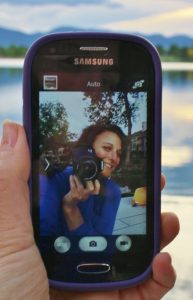As a parent and psychotherapist, I am among the many who complain that smart phones are negatively impacting our kids’ relationships, social skills and attention span. But, the good news is they have ignited popularity in photography and revolutionized the ability to take and share high quality images. Whether using a traditional camera or a smart phone, let’s celebrate the many rewards photography offers pre-teens and teens.
Among the benefits they may “develop” (pardon the pun from old school photography):
-
Appreciation of beauty in nature.
Using a camera helps view the environment in a new way and increases admiration of the outdoors. When a young photographer sees something that “looks cool”, there is likely an appreciation of its magnificence and the feelings it evokes.
-
Mindfulness.
Walking with one’s camera frequently promotes being in the present moment and increases observation skills and cognizance of the color intensity and how the light in a given moment impacts the subject.
-
Mastery/Confidence.
Learning to take artistic photos and/or photos that tell a story are skills that may build a sense of For those who may not see themselves as artists, this is an easy way to participate in art and will likely grow pride.
-
Creativity.
Picture-taking encourages creativity such as looking for a fresh angle, interesting lighting or a close up of a small detail. When a photo turns out to be a “mistake” but appears more unique and appealing than originally anticipated, this teaches the creative process and openness to risk-taking. Photo editing programs allow further opportunities to use filters and other effects to make interesting images. (Many apps provide options that simulate darkroom techniques as well.) In addition, macro, telephoto and wide angle lenses are now sold as attachments to smart phones to provide more ways to experiment.

Building an appreciation of nature – The “mistake” of glare gives this photo an artistic, unique look, encouraging creative risk-taking.
-
Decision making skills.
Each photographer chooses the subject matter, what angles to use and how to frame the subject. There also are opportunities for decision making such as “Is it appropriate to take a photo of a stranger without permission?” and “Should I post an embarrassing photo of a friend?” This is a chance to improve impulse control skills and build empathy.
-
Self-Expression.
People of all ages take pictures of places, people and events that are important to them, so photography allows teens to communicate what they find interesting, funny, cool or beautiful. If they choose to post these images along with a written statement or descriptive hashtags, they also convey their ideas and feelings about the photos.
-
Verbal Skills.
Those who do not have strong social skills may use picture-taking at a party or event as a conversation starter. For the more adventurous street photographer, asking permission to photograph people or their pets or children encourages dialogue. In addition, sharing photos in person is a chance to link generations. When visiting with grandparents, conversation may be scarce but if the grandchildren are willing to show some of their favorite photos on their phone, it will promote discussion. Whether it’s an image of a school art project, a shot of a new skateboarding park or a selfie with a BFF, it takes the viewer into their world.
-
Reflection.
Documentation of one’s personal history provides a visual journal and timeline. These images may be used in the future to recall memories and reflect on the past as well as the feelings the images provoke.
-
Identity.
Selfies assist in the developmental task of identity formation. The self-portrait, which has been around for generations, allows individuals to grapple with the age old questions: “How do I see myself?” “How do people see me?” and “How do I want people to see me?” Pre-teen and adolescent girls are known for spending a lot of time in front of the mirror (though boys do it too). The selfie is a tool to further explore her different looks and personality traits. In a world that focuses on how girls and women look as opposed to who they are, the selfie can be used to allow them to take portraits that represents their inner selves and positive aspects of their personalities.
Too much of a good thing?
Photography is a good thing – though, of course, too much of photography or pretty much anything is NOT a good thing. Always seeing the world through the cell phone camera and needing to share every moment could become excessive. Another consideration of over use is utilizing photos and social media instead of conversations. Finally, if selfie-taking and posting become obsessive, parents may need to set limits. This provides another benefit — the chance to learn balance, a life skill for all of us!
(Image credits: Copyight CLG Photographics, Inc.)
About the Author: Cathy Lander-Goldberg, MSW, LCSW
 Cathy Lander-Goldberg, MSW, LCSW, is a photographer, psychotherapist, educator and the author of PHOTO EXPLORATIONS: A Girl’s Guide to Self-Discovery Through Photography, Writing and Drawing. She also is the director of Photo Explorations and the curator/photographer for The Resilient Souls Project, a traveling exhibition, which displays portraits and writing of courageous young women who have overcome a variety of issues early in their lives and follows them two decades later into adulthood. For more information, visit www.clgphoto.com or follow Photo Explorations on FaceBook, LinkedIn and Instagram.
Cathy Lander-Goldberg, MSW, LCSW, is a photographer, psychotherapist, educator and the author of PHOTO EXPLORATIONS: A Girl’s Guide to Self-Discovery Through Photography, Writing and Drawing. She also is the director of Photo Explorations and the curator/photographer for The Resilient Souls Project, a traveling exhibition, which displays portraits and writing of courageous young women who have overcome a variety of issues early in their lives and follows them two decades later into adulthood. For more information, visit www.clgphoto.com or follow Photo Explorations on FaceBook, LinkedIn and Instagram.




I enjoyed your article and I am a parent, psychotherapist an now a grandparent of teenagers. I have watched the change to a digital community over the past 20 years. Roger Fidler called it mediamorphosis. Whether we like it or not it is the future of communication and community.
This new e-community may be difficult for us as old school to embrace and I appreciate your positive take.
I have to agree with a lot of what this article is pointing out as being a positive boost for photography, bringing along with this technology a host of other skills needed in life.
However, the evidence that growing up in a world filled with all sorts of devices actually is altering the way neurons are formed and continue to work in the brain. This is especially true in a young and developing brain. And it is scary.
As humans, the social aspects of our lives is dependent on in person, meaningful dialogues and yes, even the touch of another human. This is what we are losing, and I am seeing a frightening loss of empathy, ability to relate to others in the flesh, so to speak, and a total disruption from physical reality. In other words, these children are growing up in a virtual world as opposed to the real one.
I recommend taking a look at “The Impact of Technology on the Developing Child” by Cris Rowan to understand why the negatives far outweigh the benefits. And sadly, these devices are now amounting to an addiction. Take away or threaten to take away a child’s cell phone, computer etc. and watch the reaction. It does not bode well for that young one’s future.
Sharon,
Thanks for your comment and for sharing the reference! As a therapist and parent, I totally understand and agree with your concerns with the negative impacts of technology as well. Hoping we can teach our kids and remind ourselves of the need for balance with technology.